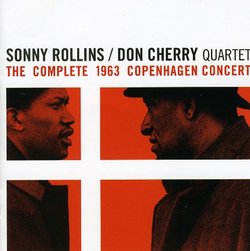Visions of Excess
jive rhapsodist | NYC, NY United States | 01/12/2010
(5 out of 5 stars)
"Yes, this is the strangest of these concerts. It starts with more than 20 minutes of Monk's 52nd St. Theme, which on all the other concerts lasts no more than a few minutes. Don Cherry is at both his swingingest and most oblique. Rollins concerns himself with a quote from Parker's solo on Dizzy Atmosphere. He attempts swinging obliqueness, ends up with some of his Caribbean-isms. The four of them are all really lit up. The performance threatens to become really wild and break free of its moorings. But it never really does. The swing is hot, sometimes almost silly, cartoonish. Indebted to the '30's in many ways. Just at that point, a Peter and the Wolf quote. The riffing, at 12 minutes, is accompanied by a relentless 2-beat pattern from Higgins. It's like some kind of Space-Age Dixieland. Higgins plays like a genius throughout this track.Rollins goes nuts with quoting. The Daring Young Man On The Flying Trapeze is particularly apposite. There's plenty of excess, but nothing is wasted.
Then comes another Green Dolphin Street. 16 - some - odd minutes. The standard routines - "Latin" on the A sections, "Swing" on the B's, Break on the last 2 bars of each chorus - treated with a kind of sarcastic derision, and yet, at the same time, respected as necessary markers, creators of shape. This is a lot to take in at once: loving the routines of Jazz, fighting the routines of Jazz, needing the routines of Jazz...
A new critical language needs to be developed in order to speak intelligently (and intelligibly) about the 26 minute long "Free" piece that ends the first disc. First off, it's definitely a failure. Second, it's a very noble failure. A little polyrhythmic 6 or 9 - beat phrase (2 or 3 3- beat phrases, actually) tries to serve as a vehicle of coherence, against which all kinds of textures and grooves strut and fret their moments upon the stage. It doesn't really work, but it's a nice try. It is interesting to think about the fact that we are only 3 years away from the beginnings of the Art Ensemble of Chicago and all the "Second Wave" of Free Jazz. They were masters at this kind of loose piece held together by an Idée Fixe. But the time wasn't quite ripe for it in 1963, I guess.
Is everything on this concert too long? Well, probably. And yet this kind of excess seems to go with the kind of uncharted waters this music is sailing on. A synthesis is proposed between Monkish thematics, Ornette - y motivic improvising, and Rollins' own vacillations between Radical and Less - Radical Mainstream. It's all Heroic and almost Epic. And Failure lurks around every corner. Thrilling! And sometimes boring, too.
On to the next disc: 12 1/2 minute Without A Song, 13 minute Oleo. Some incredible motivic madness on the first, during a long Cherry - Rollins duo. Is it great? It's reaching for greatness in a Sisyphusian way. Unique. Overwhelming. Frustrating. Fascinating. And it's so hard for these guys to find an ending! Then the second. Oleo is what it is - hard to free up Rhythm Changes...is it even worth trying? Everything starts spinning so fast. Vertiginous. So much teleology. They picture a world right outside of their grasp.
The listener really has to work while listening to this set. If you want to do that much work, this is an historically remarkable collection.
The 3 bonus tracks are unfortunately not speed corrected. They are from Graz, Austria in 1966. Rollins has moved onto his next phase - comparatively untroubled virtuosity."


 Track Listings (4) - Disc #1
Track Listings (4) - Disc #1